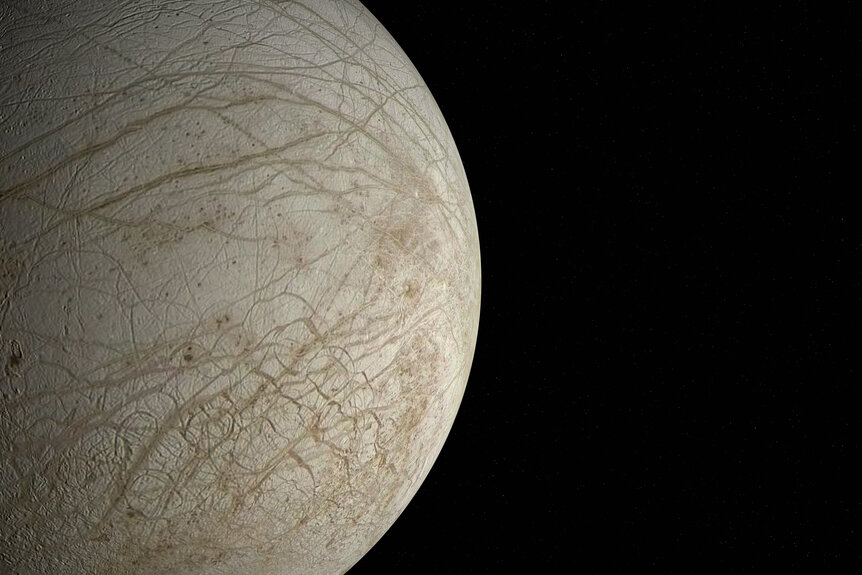Create a free profile to get unlimited access to exclusive videos, sweepstakes, and more!
It may be snowing upside down in the water beneath Europa’s surface
Europa's ice shell might be weirder than we thought.

The oft-forgotten Jumanji spin-off, 2005's Zathura: A Space Adventure, sees two brothers rocketing off to cosmic parts unknown with the simple press of a button. Unfortunately, in the real world, getting to locales even in our own solar system isn’t as easy as starting a board game with your sibling rival.
Instead, we rely on probes, landers, rovers, and ground-based science to paint an ever-clearer picture of the cosmos. One of the places in our solar system that’s of the most interest is Jupiter’s moon Europa. It’s covered over by a global ice shell, but we have reason to believe that beneath the kilometers-thick ice, there is an ocean of liquid water which might be suitable for supporting life.
NASA’s Europa Clipper mission is targeting a 2024 launch and recently moved to the Spacecraft Assembly Facility at JPL where it will spend the next two years preparing for liftoff. Once at Europa, it will complete approximately 50 flybys to gather more insight about the icy world. Outside of JPL, scientists continue to study the moon from afar, in an effort to gain additional intel which might make the mission more successful. Among them is Natalie Wolfenbarger, a graduate student researcher in the Institute for Geophysics at the University of Texas and an affiliate member of the Europa Clipper team, working on the probe’s ice penetrating radar instrument.
Wolfenbarger recently published a paper, in collaboration with colleagues, in the journal Astrobiology which provides a new view of how parts of the ice shell are forming and what might be happening just underneath.
“It’s inspired by the processes we see beneath ice shelves in Antarctica. I was trying to understand what a good analogue for ice shells on other worlds might be. Traditionally, we’ve used sea ice but the problem with sea ice is it forms a lot quicker than what we might find on other worlds. Looking at conditions like pressure, temperature, and growth rate, I realized the kind of ice forming under ice shelves is probably a more relevant analogue,” Wolfenbarger said.
While Europa and other ice worlds both in our solar system and outside of it feel like totally alien places, they are subject to the same laws of physics as we are here on Earth. If we can find an environment which closely mirrors what we think is happening on another world, it gives us a window into what might be happening there.
When scientists look beneath the ice shelves of our own world, they see ice forming in two primary ways. The first is through congelation, a process through which ice grows directly as a result of progressive cooling. The other method is a lot more interesting. Supercooled water beneath the ice shell — or shelf, depending on the location — reacts with turbulence to create crystals which flow like snow in reverse, floating up to meet the ice sheet above them.
“Counterintuitively, this process actually starts with ice melting. When deeper ice melts, it creates meltwater less dense than the ocean because it’s less salty. This light meltwater wants to float up and as it moves from a deeper place to a shallower place it is supercooled. Under those conditions it wants to crystallize and form ice, but it can’t because it doesn’t have nucleation sites. What happens on ice shelves and what we think happens on Europa is if you have turbulence and something for the ice to form on, you start making these little crystals which are called frazil ice,” Wolfenbarger said.
You might have seen something similar online or in a science class. If you take a bottle of purified water and place it into a freezer it can become supercooled. If the water is pure enough, there aren’t any particles inside around which ice can form. The temperatures are below freezing but the water remains liquid. If you then take out the bottle and slam it on a table, the turbulence causes it to rapidly crystalize into a kind of slushy ice. That’s more or less what’s happening when frazil ice forms. Once it crystalizes, it becomes even less dense because ice is less dense than water, and these little flakes of underwater snow flow upward faster and faster until they collect in the shallowest regions of the ice-ocean interface.
“We think a lot of the ice shell thickening process is probably caused by progressive cooling, which would be analogous to congelation ice. Where frazil comes into play is infilling places where we have changes in ice thickness, cracks or rifts in the ice shell. The fact that both of them occur could be important for causing some of the features we see on the surface, but that’s certainly future work,” Wolfenbarger said.
Understanding how these two ice-forming processes play together could help scientists to better know how and why different types of ice form in different places and how that interplay affects ice shell dynamics. Europa’s surface is covered in chaotic regions which might be driven by this icy relationship. In the meantime, updated models of the ice shell have a more practicable implication as it relates to the Clipper mission.
“The difficult thing about ice penetrating radar is it’s hard to understand what you’re seeing when you see it. We’re sending energy down into the ice shell and it’s going to be attenuated or reflected based upon what the ice shell is made of. When we build better models for what we think the ice shell will look like, it gives us more context to interpret the data,” Wolfenbarger said.
It might also provide novel targets for where to look for life signs on Europa. The chemistry and salinity of an environment have important effects on whether or not life can sustain itself. Wolfenbarger is particularly interested in looking to see if these collections of frazil ice might make good homes for life within Europa’s ocean. Frazil ice is necessarily closer to the surface where it would be easier for us to get our robotic hands on it when and if we send a Europa Lander mission to the icy world, but it’s also mixed in with water.
“One of our key ingredients for life is water, if we have a kind of mushy ice with a lot of water, that’s potentially a good habitat for life to inhabit,” Wolfenbarger said.
Underwater snow falling in reverse is cool enough, but if there’s something living in it, all bets are off. Who needs to go to another star when we have such weird and wonderful worlds right here in our cosmic backyard?



























